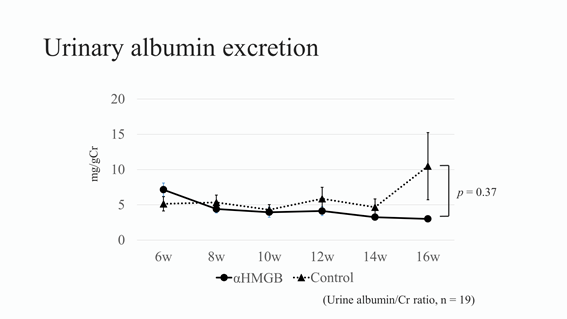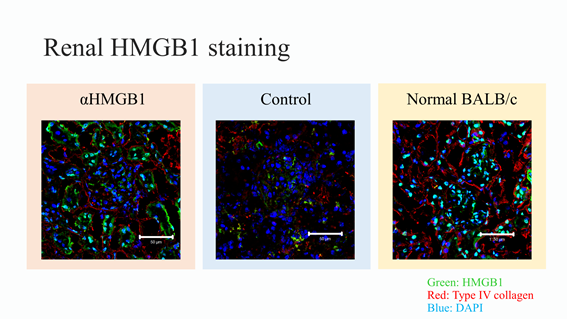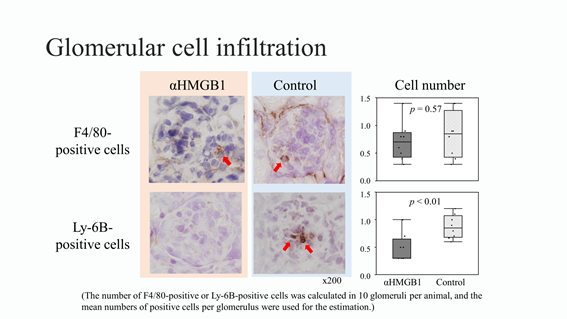Session Information
Session Type: ACR Poster Session B
Session Time: 9:00AM-11:00AM
Background/Purpose: High mobility group box 1 (HMGB1) is a ubiquitous non-histone nuclear protein that exerts proinflammatory functions in the extracellular milieu. Here we evaluate the efficacy of neutralizing anti-HMGB1 monoclonal antibody (mAb) whether it ameliorates lupus activities including nephritis and serological abnormalities in MRL/lpr lupus-prone mice.
Methods: We administered the anti-HMGB1 mAb (5 mg/kg weight) neutralizing ICAM-1-inducing activity of HMGB1 in vitro or class-matched control IgG2a intravenously twice a week from 4 to 15 weeks. Urine albumin was monitored every 2 weeks and histological evaluation of kidneys was conducted at 16 weeks. Anti-ds DNA antibody titers, cytokines and chemokines were also evaluated.
Lymphadenopathies were also evaluated by 1-(2′-deoxy-2′-[18F]fluoroarabinofuranosyl)cytosine ([18F]FAC) PET/CT at 12 weeks.
Results: Anti-HMGB1 mAb tended to reduce the albuminuria compared to an isotype control at 16 weeks. Consistent with the urinary albumin excretion, the glomerular complement deposition was improved. However therefre no significant differences in the IgG depositions and renal pathological scores between the two groups. Regarding serological abnormalities, the anti-dsDNA antibody titers, cytokine and chemokine levels were not altered. Moreover, antagonizing HMGB1 treatment failed to show significant reduction of plasma HMGB1 level and was insufficient to suppress the translocations of HMGB1 in the kidney. The plasma HMGB1 level in this model mouse tended to be high compared to C57BL/6 mice. Although therefre no significant differences in the glomerular infiltrations of F4/80 positive cells, the infiltrations of Ly-6B positive cells and Ly-6G positive area were significantly decreased by anti-HMGB1 mAb. Renal mRNA expressions of cytokine and chemokine, such as IFN-alpha, TNF-alpha and IL-6, were unaltered by the treatment with anti-HMGB1 mAb. The weights of lymphoid tissues were almost similar and [18F]FAC PET/CT revealed the similar accumulations in cervical and axilla lymph nodes in the two groups.
Conclusion: Anti-HMGB1 mAb demonstrated therapeutic potential against lupus nephritis through inhibiting neutrophil recruitments, but the abundance of HMGB1 release in this model mouse might blunt the effectiveness.
To cite this abstract in AMA style:
Watanabe H, Watanabe KS, Liu K, Yan M, Hiramatsu S, Zeggar S, Ohashi K, Katsuyama E, Miyawaki Y, Morishiata M, Katsuyama T, Narazaki M, Tatebe N, Kawabata T, Sada KE, Nishibori M, Wada J. Effects of Anti-High Mobility Group Box 1 Antibody for MRL/Lpr lupus-Prone Mice [abstract]. Arthritis Rheumatol. 2016; 68 (suppl 10). https://acrabstracts.org/abstract/effects-of-anti-high-mobility-group-box-1-antibody-for-mrllpr-lupus-prone-mice/. Accessed .« Back to 2016 ACR/ARHP Annual Meeting
ACR Meeting Abstracts - https://acrabstracts.org/abstract/effects-of-anti-high-mobility-group-box-1-antibody-for-mrllpr-lupus-prone-mice/



